Son of Former Sector 105 Secretary Testifies
Today, witness Phan Van gave his testimony in relation to Phnom Kraol Security Center. He is the son of former Sector 105 Secretary Laing alias Chhang, who had been killed during the Khmer Rouge regime. Mr. Van gave evidence with regards to the authority structure of the zone, office K-17 and security matters.
K-17
All parties to the case were present except Marie Guiraud, who was absent for personal reasons. Nuon Chea followed the proceedings from the holding cell as usual.
Witness Bophan Van alias Phan Van alias Kham Van was born in 1960 in Peam Chimiet Village, Peam Chimiet Commune, Koh Nhek District, Mondulkiri Province. He now lives in Malai District in Banteay Meanchey. His father’s revolutionary name was Laing. The floor was then given to the Co-Prosecution. Assistant Prosecutor Andrew Boyle said that he had already testified and that he would not ask questions which he had already answered. He said that the witness had been a telegram decoder for his father Laing, who had been the Sector Secretary of Sector 105. He asked him to describe the layout of the K-17 office. He replied that K-17 belonged to the sector. There was only one building. He worked in the same building as his father at the time. He decoded the telegrams in a small building. He confirmed that the compound included several buildings and that K-17 was one of the buildings on the compound. The compound was around five to ten hectares. K-17 was on top of the mountain Phnom Kraol and there were houses on the slope of the mountain. Married couples lived elsewhere than single people. The building was used to hold meetings regularly. Chiefs of the districts attended these meetings within that building. The building was a two-story building. The first floor was made out of concrete and the second floor made of wood.
He had testified in the previous case that he had been the telegram decoder from 1974 until late 1975 or early 1976, when his sister took over the office. The witness confirmed this information. After this, he became the driver of his father. His tasks were also to grow crops while being the driver. He would not drive his father to nearby offices. The witness was within a different building but in the same compound. The distance between the K-17 meeting hall and the other houses were around 100 meters. He was his father’s driver until he went to Phnom Penh with his father, where his father was killed. He could not recall the year. Mr. Boyle read an excerpt of the testimony of the witness’s sister, who had said that their father went to Phnom Penh in October 1977.[1] He said that he might have gone to Phnom Penh in late 1976 or early 1977.
There were around two or three decoders, but other staff members who also worked at the office. There were different units: kitchen, education, hospital, field and transportation, transportation. He estimated that around 1,000 people worked there, including elderly and younger people. Only around 20 people worked in K-17 itself, which included the kitchen staff.
His father was “the cadre”. Other people were sent away to study at the province. The office chief was called Tin.
K-11 and Trapeang Pring
The security center was called Ou Sophea. It was located far away and to the south of Kraol Mountain. It was more than ten kilometers away from K-17. Sophea was the chief of the security center. Mr. Boyle pointed to a Site Identification Report, which located K-11 and K-17 within a distance of a kilometer and not ten.[2] The witness answered that K-11 and K-17 were located close to each other, but since there were no direct roads, around ten kilometers were between them.
Mr. Boyle read an excerpt of his interview, in which he had talked about the Phnom Kraol Security Office under the supervision of chairman Laing.[3] After Sophea was removed, Laing replaced him. Mr. Boyle then wanted to know whether he remembered the existence of a security office near the Phnom Kraol reservoir, which he denied. “As I told you, the security office based on the real geography was located to the south and there was only one security office at the time that I was there”.
Mr. Boyle wanted to know whether he was aware of the K-11 military office, which the witness denied. “It was probably established after I left”. Mr. Boyle read an excerpt of another witness, who had said that prisoners at the Phnom Kraol Security Center K-11 were considered heavy prisoners.[4] The witness replied that he could not remember well and that K-11 did not exist when he was there. Khieu Samphan Defense Counsel Kong Sam Onn objected when Mr. Boyle asked about the Phnom Kraol Security Center, since he said that he did not know about the security office. The objection was upheld. Mr. Boyle said that he was referring to Phnom Kraol, as mentioned by the other witness, who had said that the chance of survival at Phnom Kraol was very slim. The witness could not give further information on this.
Mr. Boyle asked whether he had heard of Trapeang Pring, which was located around four kilometers to the west of Phnom Kraol on the way to Kratie. The witness had not heard of this location.
Mr. Boyle read a statement of another witness to refresh the witness’s memory.[5] The witness replied that there was no place called Trapeang Pring at the time that he was there. Seeking clarification, Mr. Boyle read an excerpt of the witness’s statement, who had referred to a person called Van.[6] Mr. Van explained that Van was his younger brother, who was better aware of the security office. He denied that there was any detention at the K-17 during the time that he was there. Mr. Boyle said that two witnesses had been detained at K-17 within a large group of people connected to the network of Kham Phoun. Moreover, Neth Savath had testified having seen people detained at the office.[7] The witness said that he could not remember that there were any 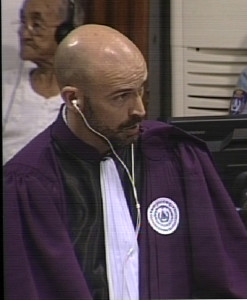 detainees while he was at the office. People would only attend normal training sessions there. The witness insisted that there were no arrests at K-17 while he was there. He knew that arrests happened in general. “During the regime, it was widely known that certain individuals betrayed the regime”. Mr. Boyle referred to a telegram that the witness’s father had sent on 20 May 1977 and that referred to an individual Chhin.[8] Mr. Boyle wanted to know what the Tuoy Chauy Office that was mentioned in the telegram. He replied that Chauy was a military officer. He was chief of a battalion. The battalion was posted along the border to Vietnam. He heard that certain individuals disappeared. Mr. Van denied any knowledge about whether his father took decisions to arrest people.
detainees while he was at the office. People would only attend normal training sessions there. The witness insisted that there were no arrests at K-17 while he was there. He knew that arrests happened in general. “During the regime, it was widely known that certain individuals betrayed the regime”. Mr. Boyle referred to a telegram that the witness’s father had sent on 20 May 1977 and that referred to an individual Chhin.[8] Mr. Boyle wanted to know what the Tuoy Chauy Office that was mentioned in the telegram. He replied that Chauy was a military officer. He was chief of a battalion. The battalion was posted along the border to Vietnam. He heard that certain individuals disappeared. Mr. Van denied any knowledge about whether his father took decisions to arrest people.
At this point, the President adjourned the hearing for a break.
Arrests of cadres
After the break, Mr. Boyle resumed his line of questioning. He inquired about two individuals: Ta Soy was the deputy of Ta Chhin, who was the leader of Division 920. [9] Ta Chhin and Ta Soy were arrested because of betrayal.
They were called to work in Phnom Penh. Mr. Boyle referred to a prisoners list of S-21, which indicated that they entered S-21 in January and March 1977.[10] The witness could not remember the dates. Mr. Boyle then referred to the witness’s statement, in which he had talked about his father being in favor of negotiating with Vietnam instead of going to war with them.[11] The witness recounted that the people disappeared after coming back from a meeting. The meeting took place in Mondulkiri Provincial City. He could not remember the date. Vieng was in charge of the battlefields.
Mr. Boyle wanted to know whether he ever saw messengers delivering messages from Phnom Penh to K-17. The witness did not know. Mr. Boyle then wanted to know whether confessions had been sent from Phnom Penh to Sector 105.[12] Mr. Van said that he was not aware of this matter. He did not know the name Horm Ham, but knew this person’s alias Sy. He was the district secretary. Orn Sy was the younger brother of his father.
Mr. Boyle quoted the witness, who had said that people who committed moral offences and evaded work were arrested and sent to Phnom Kraol Security Office.[13] He confirmed that there were cases like this. Mr. Boyle gave another reference.[14] Mr. Van said that his father was following instructions from above. His father forwarded the instructions from Phnom Penh to the district secretary. However, Mr. Van did not know about instructions as to who was supposed to be considered enemy. Messages came through telegrams advising on specific issues, but did not know who gave these instructions. Mr. Boyle read a part of his interview, in which he had said that Nuon Chea issued instructions with regards to security matters.[15] He had also confirmed this in his previous testimony. Mr. Van now said that the content was much more than what had been mentioned before, but that this happened. He confirmed that these were the kinds of messages that his father passed on to the district. He could not recall how often his father went to Phnom Penh for meetings. After his return from Phnom Penh, his father called people for meetings at K-17. At this point, Mr. Boyle handed the floor to the Civil Party Lead Co-Lawyers.
Telegrams
Civil Party lawyer Sin Soworn turned to the time that Mr. Van became a messenger and wanted to know when he took this role. He replied that he could not remember the exact date, but it was when aerial bombing intensified. He said that it might have been in 1973. He did not have other functions than being the decoder.
He delivered letters to Pol Pot and Uncle Nuon, who was Nuon Chea according to the witness. He saw them in houses. He was “a pretty young boy” at the time. He had heard of the office 870, but did not know about the location. He saw that the envelope of the letter said that it was addressed to Office 870. Sector 105 only included Mondulkiri.
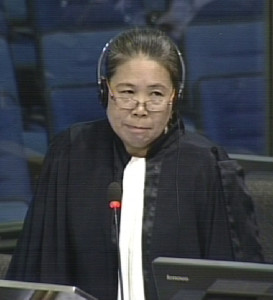
Civil Party Lawyer Sin Soworn
Ms. Soworn then wanted to know how his father reported to the upper level. He replied that he communicated through telegrams and made oral reports when he went to Phnom Penh. Next, Mr. Boyle wanted to know whether he decoded messages in relation to purges and killings, which the witness did not know. He did not know content of letters, even when decoding the messages. Some telegrams were from districts, some were from the upper echelon and others were from units at the borders. There were telegrams from 870 and other offices. Sometimes the names of the senders were indicated, and most of the time he could read the name of Uncle Nuon. The messages concerned the soldiers at the borders.
When Ms. Soworn asked about the disappearance of his father, Mr. Koppe objected and said that the father did not disappear but that his fate was clear. Ms. Soworn said that the witness himself had used the word disappearance. The objection was overruled. The witness did not know anything about instructions prior to his father’s disappearance. His father was called to attend the training session in Phnom Penh after Kham Phoun’s child had been arrested. “I just wanted to know why [my father] died”, and there was an announcement that Kham Phoun had killed his father. However, no one believed this, since the two individuals worked closely together and were related.
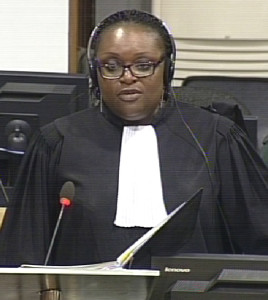
International Khieu Samphan Defense Counsel Anta Guissé
He was reassigned to grow vegetables and work with Ieng Tirith after his father died. He was her messenger. Sometimes he drove her to the dams. At this point, Ms. Guissé interjected and said that the witness had been called to testify about Phnom Kraol and had already testified earlier. She therefore objected. Ms. Soworn moved on and inquired about his father’s fate.
His father was in charge of around 1,000 people at K-17. The food in the cooperative was “just enough for them”, and they received food two or three times a day. Not many people who were arrested and sent to Phnom Kraol had committed moral offences.
Some people were required to get married. Unit chiefs requested them to do so. The witness himself got married in 1985. Some of the people were happy with their spouses, while others were “trying their best to live along with their spouses”. One soldier killed himself when not being able to marry a woman. He did not know the individual called Sun Voeun. At this point, the President adjourned the hearing for lunch break.
Fighting with Vietnam
After the lunch break, the floor was granted to the Nuon Chea Defense Team. Defense Counsel Victor Koppe quoted his testimony of 11 December 2012. The witness had said that “there were enemies fighting with our forces along the border” and that the infiltrated forces were those that were not trusted anymore.[16] Mr. Koppe asked whether he recalled having said this to the Trial Chamber in 2012. The witness confirmed this. Mr. Koppe then wanted to know what he recalled about the fighting of their forces along the border. He replied that he could recall the fighting with the Vietnamese soldiers. His source of knowledge was that he heard continuous gunshots. He could not remember anything else. Mr. Koppe then asked about a telegram sent by his father to Office 870, which was signed by Chhang.[17] His father had the name Laing initially and changed it to Chhan later. His father never used the name Ham according to Mr. Van. Next, Mr. Koppe asked about another telegram of 20 June 1977, which was sent from from Sophea to his Laing and which mentioned a so-called 7-Group.[18] The witness said that he did not know about the content of this telegram. Mr. Koppe asked whether this refreshed his memory, perhaps also in relation to other attacks. Mr. Van said that he did not understand the question. Mr. Koppe rephrased his question. Mr. Van said that he remembered Vietnamese incursions. In this telegram, a “7-Group” was mentioned. The witness had never heard of this group. Mr. Koppe wanted to know how he had not heard of this group if he was involved in decoding telegrams. The witness insisted that he had never heard of this group.
Mr. Koppe read an excerpt of a 920 Division Soldier who had testified last week. Mr. Koppe referred to Civil Party Sun Vuth, who had confirmed Mr. Koppe’s question whether the Vietnamese always attacked Cambodia and that Democratic Kampuchea never encroached upon Vietnamese territory.[19] Mr. Koppe inquired whether the witness agreed or disagreed with what the Division 920 soldier had told the Trial Chamber last week. Mr. Van agreed and said that there were incursions by Vietnamese soldiers onto the territory of Cambodia. He did not agree with the statement that the Vietnamese always encroached and not the other way around. He said that he did not know whether they had the intention to violate Cambodian territory.
Internal enemies
Moving to his next set of questioning, Mr. Koppe asked what the witness had meant with different factions and groups that existed internally. He replied that he had referred to internal enemies. Those who were accused of betrayal were seen as internal enemies. Mr. Koppe asked whether those who collaborated with Vietnam were also seen as internal enemies. The witness explained that this was not specific: everyone who was accused of not following the orders were seen as the internal enemies.
Mr. Koppe asked whether he had heard of the Kham Phoun movement, which the witness denied. Mr. Koppe wanted to know whether Kham Phoun was accused of treason. He said that he initially did not know this. After Kham Phoun’s death, they had made an announcement that Kham Phoun was a spy for Vietnam. He did not know what specific allegations were made.
Mr. Koppe asked whether he had heard that Kham Phoun were accused of bringing Vietnamese spies into the territory and were feeding them. He said that he had heard that they had contact to the Vietnamese. His father had not told him anything about this.
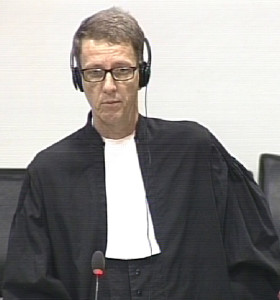
International Nuon Chea Defense Counsel Victor Koppe
Mr. Koppe referred to his sister’s statement, who had also talked about “feeding the yuon”, Mr. Koppe said, and asked whether this sounded familiar to him.[20] Mr. Koppe asked whether his father ever told him about activities of Svay and Kham Phoun to feed the Vietnamese, bring in guns and bringing in Vietnamese spies. The witness said that his father had not told him about this, but that the announcement was made about it.
Mr. Koppe then inquired about Division 920 and sought information about this division. The witness said that he neither knew about the structure of this division nor heard about the arrest of a number of Division 920 soldiers. He did not know the codes for the divisions in the old zone. Ta Chhin knew about the structures. Neither did he know anything about a connection between different cadres. Mr. Koppe asked whether had heard that Ouen Soeun, Chhin were closely connected to Koy Thoun, Mr. Van confirmed having heard about this. He did not know how closely they were related to each other, but knew that they “were together”. He did not know whether Ya had a connection to them other than they knew each other. Nor did he know about any specific connection between Ya and Koy Thoun. He had heard of Chan Chakrei. “I heard that he was one of the outstanding military commanders”.
At this point, Mr. Sam Onn interjected and said that there was a smell in the court room that smelled like something was burnt or leaking gas. Mr. Koppe said “it’s not me, Mr. President”, and laughed.
Mr. Koppe inquired further about this individual. The witness said that he had heard of his name. Mr. Koppe wanted to know whether he knew if he came from the North as Oeun, Soeun and Syn, which the witness did not know. Mr. Boyle interjected and said that open questions should be asked first and then questions with references afterwards.
Mr. Koppe asked whether he knew anything about a plan by Division 410, 450 and 920 to attack Pochentong airport and engage in a coup d’état. The witness did not know anything about this. When Chhin was arrested it was announced that it had “something to do” with the KTB, CIA or Vietnamese network. Mr. Koppe wanted to know whether he had heard of gunfire and hand grenades being thrown at the Fine Arts Academy near the Royal Palace in early April 1976, which the witness denied. Mr. Koppe asked whether it was fair to say that he had no specific knowledge about security related matters, at which point Mr. Boyle objected. He said that the witness had already provided some evidence. Mr. Koppe said that he understood the objection, but that he tried to understand the level of his knowledge. With this, Mr. Koppe finished his line of questioning.
Security Center at Phnom Kraol
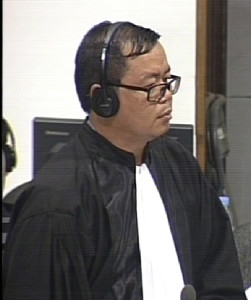
National Khieu Samphan Defense Counsel Kong Sam Onn
The floor was given to the Khieu Samphan Defense Team. National Defense Counsel Kong Sam Onn asked about the office of Ou Sophea and asked whether he knew this office. The witness replied that it was the “military location or the Security Center”. He used to go there. He could not recall the exact location, “since the geographical area has changed since that time”, but that he went there on Phnom Kraol. Mr. Sam Onn then quoted his Written Record of Interview, which indicated that he never went to the security center and it was 17 kilometers away from K-17.[21] He answered that he did not work and stay at that office, but that he travelled past that office. He confirmed that he never went inside the office.
Mr. Sam Onn asked how he learned that Laing replaced Sophea. He replied that it was indicated in an announcement in a meeting. Laing was in charge of the security in sector 105. Sophea was “the superior”. After the removal of Sophea, Laing first replaced him and then Laing was also replaced. Everyone was invited to that meeting. The content of the meeting was about those who were traitors and who replaced whom. The witness himself was present in the meeting. The meeting was to inform the people about the security matters.
With this, Mr. Sam Onn finished his line of questioning. Since there was no reserve witness, the court was adjourned already at 2:30 pm. The next hearing will be on Monday, April 18 2016 with the testimony of 2-TCCP-243.
[1] E3/44, at 00295164 (EN), 00287715 (KH), 00353129 (FR).
[2] E3/8057, at 00371404 (KH), 00365620 (EN), 00371275 (FR).
[3] E3/58, at 00250088 (EN), 00239936 (KH), 00283914 (FR).
[4] E3/5178, Bun Loeng Chauy, at 00274101 (EN), 00197862 (KH), 00485186 (FR).
[5] E3/5222, at 00242157-58 (EN), 00236737-38 (KH), 00372821 (FR).
[6] E3/57, at 00290508 (EN), 00287705 (KH), 00353104 (FR).
[7] E1/400.1, at 10:59:47.
[8] E3/877, Telegram.
[9] E3/58, at 00250088-89 (EN), 00239936 (KH), 00283914 (FR).
[10] E3/342, S-21 Prisoners list.
[11] E3/58, at 00250092 (EN), 00239940 (KH), 00283918 (FR). E3/57, at 00290507 (EN), 00287704 (KH), 00353103 (FR).
[12] E3/366, at 00250750 (EN), 00242413-14 (KH), 00283165-66 (FR).
[13] E3/58, at 00250088 (EN), 00239936 (KH), 00283914 (FR).
[14] E1/152, at 09:57.
[15] E3/58, at 00250089 (EN), 00239937 (KH), 00283915 (FR).
[16] E1/151, at 15:44.
[17] E3/877.
[18] E3/1030, at 00324806 (EN), 00033312 (KH), 00623150 (FR).
[19] Transcript of March 31 2016, at 11:01.
[20] E3/7960, at 00450295 (EN), 0073899 (FR), 00851665-66 (KH). E3/44, at p. 5, 00295163 (EN).
[21] At 00287205 (KH), 00353104 (FR), 00290508 (EN).
